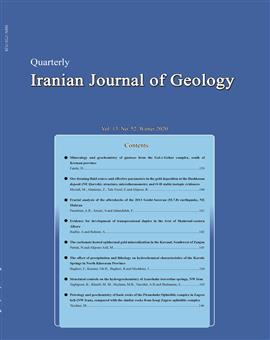نقش کنترلکنندههای ساختاری در هیدروژئوشیمی چشمه¬های تراورتن ساز منطقه آذرشهر، شمالغرب ایران
الموضوعات :کریم تقی پور 1 , محمد مهدی خطیب 2 , محمودرضا هیهات 3 , عبدالرضا واعظی هیر 4 , اسماعیل شبانیان 5
1 - دانشگاه بیرجند
2 - دانشگاه بیرجند
3 - ، دانشگاه بیرجند
4 - دانشگاه تبریز
5 - دانشگاه تحصیلات تکمیلی علوم پایه زنجان
الکلمات المفتاحية: چشمه¬, های تراورتن ساز کنترلکنندههای ساختاری هیدروژئوشیمی دریاچه ارومیه,
ملخص المقالة :
نهشته های تراورتن منطقه آذرشهر، واقع در شمالغرب ایران، یکی از مجموعه های منحصربهفرد تراورتن در دنیا می-باشد. فرایند نهشت تراورتن در حال حاضر نیز در تعدادی از چشمههای فعال تراورتن ساز ادامه دارد. در این پژوهش با تلفیق داده های ساختاری و تکتونیکی، مطالعات ژئوفیزیکی و مطالعات هیدروژئوشیمیایی به مطالعه منشا آب و جایگاه چشمه های فعال تراورتن ساز پرداخته شد. نتایج حاصل از اندازهگیریهای برجا و تیپ تراورتن ها نشان داد که این چشمه ها از نوع ترموژن و با منشا هیدروترمال هستند. بررسی دیاگرام های هیدروژئوشیمیایی و نسبت های یونی نشان داد که تیپ آب چشمه ها از نوع کربناته کلسیک می باشد که در اثر اختلاط با آب های شور، میزان یون سدیم و کلر افزایش یافته است. مجاورت این نهشته ها با دریاچه ارومیه و بررسی نتایج حاصل از مطالعات ژئوفیزیک نشان داد که منشا این آب های شور، آب دریاچه ارومیه و یا شورابه های مرتبط با آن می باشد که از طریق سیستم های شکستگی هدایت شده و در پهنه های کششی بین گسل ها با سیالات هیدروترمال اشباع از بی کربنات اختلاط یافته اند. این پدیده نشان می دهد که هیدروژئوشیمی چشمه های مزبور تحت تاثیر آب دریاچه ارومیه و یا شورابه های مرتبط با آن در قاعده تراورتن ها میباشد.
تقی پور، ک. و عباسی، م.ر.، 1384. تراویتونیک: کاربرد نهشته های تراورتن در تکتونیک فعال. بیست و چهارمین گردهمایی علوم زمین. سازمان زمین شناسی و اکتشافات معدنی کشور، 56-57.
تقی پور، ک. و محجل، م.، 1392. ساختار و نحوه تشکيل پشته¬های تراورتن در منطقه آذرشهر، آذربايجان، شمال باختر ايران. فصلنامه زمین- شناسی ایران، 25، 15-33.
شارمد، ت.، حسینی، س. ع. و محمدزاده، س.، 1394. گزارش هیدروژئوشیمی محدوده های مطالعاتی آذرشهر، شیرامین، عجب -شیر و مراغه. سازمان زمین شناسی و اکتشافات معدنی کشور، 165.
صداقت، م.، 1378. زمين و منابع آب، انتشارات دانشگاه پيام نور، 376.
قدیرزاده، ا.، 1381. نقشه زمین شناسی 1:100000 آذرشهر. سازمان زمین شناسی و اکتشافات معدنی کشور.
Alavi, M., 1994. Tectonic of the Zagros orogenic belt of Iran: New data and interpretations. Tectonophysics, 229, 211-238.
Al-Bassam, A.M., Awad, H.S. and Al-Alawi, J.A., 1997. Durov Plot: A computer program for processing and plotting hydrochemical data. Ground Water, 35, 362-367.
Altunel, E., 2005. Travertines: neotectonic indicators. In: Ozkul, M., Yagiz, S., Jones, B., (eds). Travertine, Proceedings of 1st International Symposium on Travertine, September 21–25, 2005, Denizli-Turkey, 120–127, Kozan Ofset, Ankara.
Altunel, E. and Hancock, P.L., 1993. Active fissuring and faulting in Quaternary travertines at Pamukkale, western turkey. Zeitschrift für Geomorphologie (Z Geomorph NF), 94, 285–302.
Atabey, E., 2002. The formation of fissure-ridge type laminated travertine-tuff deposits microscopical chacteristics and diagenesis, Kirşehir, central Anatolia. Bulletin of the mineral research and exploration, 123–124, 59–65.
Bargar, K.E., 1978. Geology and thermal history of Mammoth Hot Springs, Yellowstone National Park. Bulletin of the United States Geological Survey, 1444, 1-55.
Byrdina, S., Vandemeulebrouck, J., Cardellini, C., Legaz, A., Camerlynck, C., Chiodini, G., Lebourg, T., Letort, J., Motos, G., Carrier, A. and Bascou, P., 2014. Relations between electrical resistivity, carbon dioxide flux, and self-potential in the shallow hydrothermal system of Solfatara (Phlegrean Fields, Italy). Journal of Volcanology and Geothermal Research, 283,172-182. DOI:10.1016/j.jvolgeores.2014.07.010.
Caine, J.S., Evans, J.P., & Forster, C.B., 1996. Fault zone architecture and permeability structure. Geology, 24, 1025-1028.
Chafetz, H.S. and Folk, R.L., 1984. Travertines: depositional morphology and the bacterially constructed constituents. Journal of Sedimentary Petrology, 54, 289-316.
Dilsiz, C., 2006. Conceptual hydrodynamic model of the Pamukkale hydrothermal field, southwestern Turkey, based on hydrochemical and isotopic data. Hydrogeology Journal, 14, 562–572.
Ford, T.D. and Pedley, H.M., 1996. A review of tufa and travertine deposits of the world. Earth Science Review, 41,117–175.
Guo, L and Riding, R., 1998. Hot-spring travertine facies and sequences, late Pleistocene, Rapolano Terme, Italy. Sedimentology, 45,163–180.
Gudmundsson, A., Gjesdal, O., Brenner, S.L. and Fjeldskaar, I., 2003. Effects of linking up of discontinuities on fracture growth and groundwater transport. Hydrogeology Journal, 11, 84–99. doi:10.1007/s10040-002-0238-0.
Hancock, P.L., Chalmers, R.M.L., Altunel, E. and Çakir, Z., 1999. Travitonics: using travertines in active fault studies. Journal of Structural Geology, 21, 903-916.
Hounslow, A.W., 1995. Water quality data: analysis and interpretation. CRC Press LLC, 416.
Liu, Y., Zhou, X., Fang, B., Zhou, H. and Yamanaka, T., 2012. A preliminary analysis of the formation of travertine and travertine cones in the Jifei hot spring, Yunnan, China. Environment Earth Sciences, 66:1887–1896.
Pantecost, A., 2005. Travertine. Springer publications, 445.
Sikdar, P. K., Sarkar, S. S. and Palchoudhury, S., 2001. Geochemical evolution of groundwater in the Quaternary Aquifers of Calcutta and Howrah, India. Journal of Asian Earth Sciences, 19, 579–594.
Singhal, B.B.S. and Gupta, R.P., 2010. Applied Hydrogeology of Fractured Rocks. Springer, 408.
Taghipour, K., Khatib, M.M., Heyhat, M., Shabanian, E. and Vaezihir, A., 2018. Evidence for distributed active strike-slip faulting in NW Iran: The Maragheh and Salmas fault zones. Tectonophysics, 742–743, 15–33.
https://doi.org/10.1016/j.tecto.2018.05.022.


